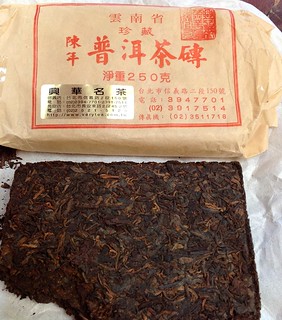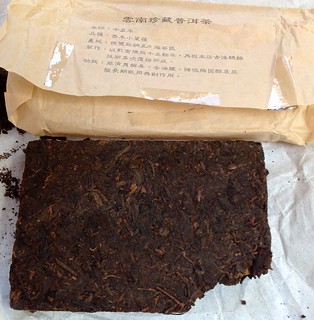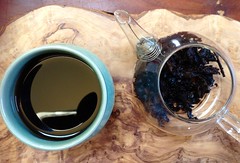 The joy of being a packrat is that sometimes you refind a treasure you had completely forgotten about. Once I found two crisp hundred dollar bills in my copy of the Wind in the Willows. I was happy for a few seconds, but then soon felt quite defeated knowing how many books I trade and donate. But this week, I was richly rewarded by my forgetful ways.
The joy of being a packrat is that sometimes you refind a treasure you had completely forgotten about. Once I found two crisp hundred dollar bills in my copy of the Wind in the Willows. I was happy for a few seconds, but then soon felt quite defeated knowing how many books I trade and donate. But this week, I was richly rewarded by my forgetful ways.So let's continue on with this mystery from circa 2000. Even before I started drinking pu-erh, I used to order oolong from Taiwan. In one shipment they had mysteriously included this brick for free. It smelled so funky back then that I immediately wrapped it up in a brown paper bag but I couldn't force myself to throw it away. I vaguely thought it was Tibetan tea and maybe I would be lucky enough to find yak butter someday to brew it up proper. I wondered how the vendor thought this gnarly brick would fit into the delicate sensibilities of an oolong drinker but I am happy they did. I stashed this brick away in various kitchen cabinets forgotten over a decade until this week.
 You can see the leaves are rough and twiggy and that I had made serious inroads in drinking it last week. There is a sticker on the wrapper which lists http://verytea.com.tw/ but I got this tea via a different vendor which I can no longer remember despite a diligent search. The wrapper definitely is new since it has verytea's phone number on it. I also tried taking the way back machine and looking through their website to even figure out if verytea ever sold this brick on their on-line catalog. No luck. (This is an aside, but it's pretty fun to do time travel with the way back machine to check out pu-erh selections and prices from the past. I should do a post next week. But have a look at these sites that use static html- tuochatea in 2005, Holy Mountain in 2005. Dang... I really missed some gems... )
You can see the leaves are rough and twiggy and that I had made serious inroads in drinking it last week. There is a sticker on the wrapper which lists http://verytea.com.tw/ but I got this tea via a different vendor which I can no longer remember despite a diligent search. The wrapper definitely is new since it has verytea's phone number on it. I also tried taking the way back machine and looking through their website to even figure out if verytea ever sold this brick on their on-line catalog. No luck. (This is an aside, but it's pretty fun to do time travel with the way back machine to check out pu-erh selections and prices from the past. I should do a post next week. But have a look at these sites that use static html- tuochatea in 2005, Holy Mountain in 2005. Dang... I really missed some gems... )Only in the very first brew I detected a subtle mold flavor which I recognize as wet storage, but it was not unpleasant. Even with my summer allergies, I can tell there was something special going on. This twiggy brick had more layers of complexity, medicinal bark overtones, camphor than any other shu I've tasted which are from a narrow range of Menghai, CNNP, Feng Qing, Haiwan, et al. Unlike most of the shu's I tolerate, there really was a there there. And it left a lovely sweetness on my tongue for an hour afterwards. I was so taken aback that this brick was so much better than I expected, I drank this tea four times during the weekend with different brew parameters to make sure. You can brew it dark which brings out a roast coffee flavor. Unfortunately this brick lasts only two steeps.
This tea must have been wet-stored even if briefly. There were carbonized black hard leaves which Jason points out in his blog as evidence of wet-storage. I did see a few white dots of mold just in one section. What's making this tea so above my ho-hum shus? The question begs to be asked, is it complexity from the wet storage or the decade in dry storage or both? I think the decade of dry storage definitely aired out that barnyard smell but the extra something special is definitely from the early wet storage because my 2001 FengQing does not have this special depth (for a shu).
But then I finally spend $15 to get the handwriting character plugin for Pleco on my ipad so I can figure out what the wrapper says. I spend a painful amount of time wiggling my fingers to draw the label text just get "Taipei City Rd." But then the back wrapper says- 年份:十五年 (niánfèn- a particular year: 15 years). OMG, it was 15 years when it came to me (or maybe less if the vendor is not to be trusted.). It's now a 25 yr. old. OMG. It's not the most mind blowing tea but it was free and it sure beats all my other shu's hands down.
Wet storage on a shu seems kinda dangerous, just a step away from compost. I procured mostly high end Menghai shus and gong-ting tribute beengs but maybe I should have been slumming it with the cheap rough bricks with a Guangzhou past. Now this gem has given a new path for my shu drinking.

What's interesting is not that it was 15 years old, but rather the claim, also on the back, that the brick was roasted multiple times by the shop (the one in the gold sticker)
ReplyDeleteHow can you tell that it was roasted? Is it a gradual increased redness towards the left?
DeleteMarlon,
DeleteMarshal is not using any deductive powers, he is just reading the back of the package, which, alas, if you don't read Chinese, might as well be powers of magical-wizard level insight :)
Where you see each colon mark, there is various information about the tea. For instance, the very first line says the tea is 15 years old. Towards the latter part of the fourth point is the claim that the tea has been reroasted multiple times during the duration of its 15 years in storage. This kind of thing is pretty common in the packaging in teas, including less objective, more fluffy marketing blips that are supposed to get your attention like, "smooth taste," or "natural taste," etc..
This explains the initial roast coffee flavors. Is this a common practice? I imagine it was to replace that moldy wet-stored taste but it was still kind of gross when I first got it. This brick was free so I imagine it wasn't of that much value even back then. I almost half expected to throw it away if it tasted super moldy but I was pleasantly surprised to like it so much. I'll send you a sample so you can tell me I can happily get stuff like this for cheap in Taiwan- this would be a fantastic replacement for my regular shu drinking if I can get it cheaply enough.
ReplyDeleteNo, this is not a common practice, and it seems like the shop practiced their roasting skills on it. I can see why it can do interesting things to the tea (and maybe why they rewrapped the bricks).
Delete